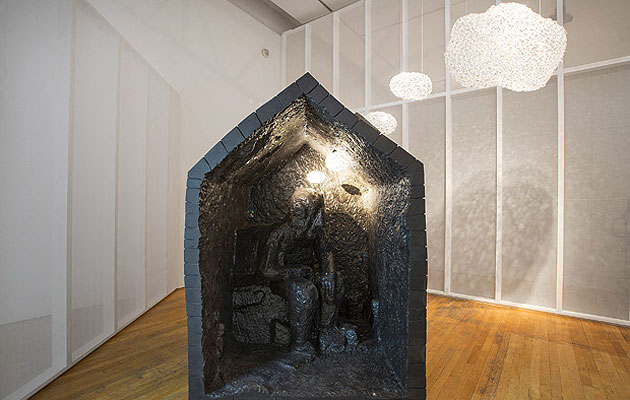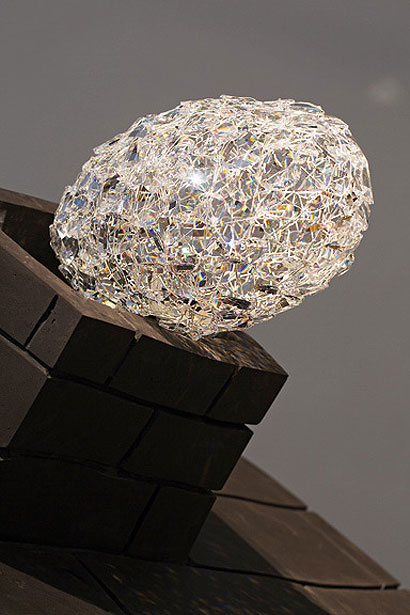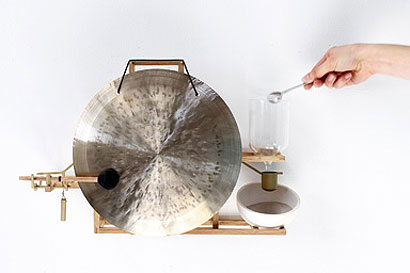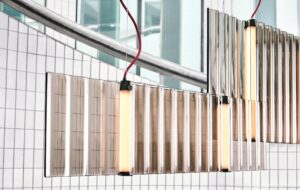|
|
||
|
“I have this image of Swarovski being all bling-bling and glamorous,” says Maarten Baas, discussing Thought Cloud, his installation for the luxury brand’s Digital Crystal exhibition at the Design Museum. “I found it quite difficult to make something for them because I’m the opposite of that. So I had to see what I could do without it becoming superficial.” He need not have worried. Thought Cloud carries all the marks of the Dutch designer’s dark expressionist style. A rudimentary house is made in black synthetic clay. Inside sits the abstracted figure of a man, almost in the pose of Rodin’s Thinker, while clouds of dazzling white crystals escape from his head and out of the house’s chimney. “A cloud is already a gathering of crystals in a way,” he explains. “I had this idea of a thought-cloud that uses the crystals for their qualities of being shiny and fresh, but then contrasting them with this dark image on the other side.”
The house is made from a synthetic composite material, the same that gives Baas’s strange and spindly Clay Furniture (2006) its malleable appearance. Thought Cloud has a rougher texture – Baas hand-moulded the shapes around a foam base and the surfaces still show the marks of his hands, shaping, almost clawing at the material to give it its final form. Digital Crystal was a look at cut-glass in the digital age, challenging designers to think about the future of memory by using Swarovski crystal in unexplored ways. The Austrian heritage brand is well known for its support of experimental designers. This latest exhibition invited a new batch of names into the fold as well as updating original pieces, such as Ron Arad’s text-message-displaying Lolita Chandelier (2004) and Fredrikson Stallard’s Pandora (2007), 2000 crystal beads suspended on invisible wires that are controlled to move digitally. Troika and Random International took a technological approach, with Hardcoded Memory and Sunlight Video respectively, using the crystal as lenses to project light and patterns. Baas says: “I imagine it is interesting for a brand to go in many directions. To let itself be surprised by what is possible. One designer might work [with its crystal] in a very technical way, another in a very poetic way, another in a more associative way. I think there is a genuine curiosity to what they expect. For mine, I tried to find some edge and I enjoyed that they let me do that.”
Last year Baas also realised Just About Now, a project for kinetic object manufacturer Laikingland. The curious and elegant wallpiece is essentially an elaborate sand timer. A while after the sand in the timer runs out, it bangs a small brass gong. Its non-exact nature, like previous video works Real Time (2009), Baas says is a more poetic way to illustrate time passing than the precision of a digital clock. The end of 2012 left Baas in a self-critical place, possibly a point of departure from design altogether. For now, he has chosen to step back from the whirlwind cycle of launching products and showing new projects. Echoing the contemplative mood of the figure in Thought Cloud, he says: “It’s healthy sometimes to just do nothing. I’ve always worked intuitively and now I’ve reached an interesting point that brings me to somewhere else than just making another thing. In a global sense too, I think designers should think more about their role. Not just make the next trendy product, but to really think about their place in the world, perhaps even re-invent the job of a designer.” |
Image David Levene; Laikingland
Words Riya Patel |
|
|
||



















